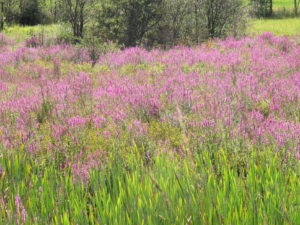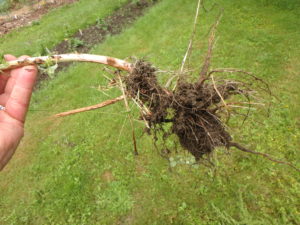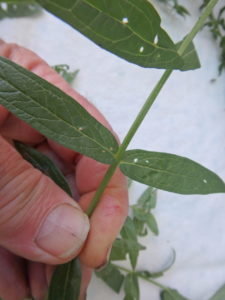Beware the Purple Invader
This is the time of year when swampy areas often are ablaze with gorgeous pink-purple flowers that dominate the wetland. These are the flowers of purple loosestrife (Lythrum salicaria), an invasive plant that you should not encourage – but that you probably can’t get rid of once established.
Most invasive plants come from another continent, start easily from seed, are difficult to eradicate, and often have no natural predators away from their homeland. That is certainly true of purple loosestrife.
But why worry about this purple invader? It’s such an aggressive grower that it out-competes native plants. It moves into shallow wetlands where fish and frogs lay their eggs among native plants, creating a dense mono culture. Biodiversity is healthy for the environment, and purple loosestrife inhibits many other kinds of plants from growing.
Mature plants develop massive root systems that will challenge even the strongest backs so they can’t be dug out. They also develop long side-roots that will easily break off and start new plants if you try to remove the clumps.
A big clump can produce up to 2.7 million seeds in a year. And like time-release cold capsules, the seeds become active over time, not all in one year. And since they grow in wetlands, you can’t use herbicides. So what can you do? There are steps you can take to reduce the problem.
If you have big, established plants the best thing to do is cut them down multiple times each summer, just above the soil line. This will prevent them from flowering and producing seeds. It will also reduce the vigor of the plants. It won’t kill them, so this is a lifetime job, like it or not. A string trimmer will do the job, if you have one.
You can, however, pull out or dig out first or second year plants, so need to be able to identify them. Look for plants with a square stem that quickly get 18 to 24 inches tall, and may have a reddish-brown tinge to their stems. Older plants get to be 3 to 7 feet tall or more. Leaves are long and narrow with a smooth edge, and they attach directly to the stalk – without an attachment stem. Leaves generally appear in pairs, across from each other on a stalk. Many flower stems arise from the main stem.
There is, perhaps, relief in sight. In some states, including Rhode Island, Connecticut and Massachusetts in New England, have programs to introduce non-native beetles that will eat the purple loosestrife. Two beetles, Galerucella calmariensis and Galerucella pusilla, have been introduced and found effective in reducing stands of loosestrife.
Will those beetles eat your peonies or tomatoes? No. The process for introducing a new species is carefully regulated by our government to protect our crops and gardens from new pests. These two species of beetles were tested on many crops while kept in quarantine before being released. They specifically eat purple loosestrife, but not other plants.
The beetles will never completely eradicate loosestrife. As loosestrife populations dwindle, so do numbers of the beetles. If the loosestrife starts to spread, the number of beetles rebounds. The bad news? You can’t buy these beetles. I’m not sure why.
Purple loosestrife, like most problem plants, is from another continent – in this case, Europe and Asia. I’ve read that the seeds of purple loosestrife probably came on sailing vessels that used sand or soil as ballast to balance their loads in the 18th century. That soil was dumped on arrival and a few seeds found a foothold. Without any natural predators, the plants spread.
Birds are often agents of distribution of seeds of invasive plants. They eat the seeds, which are often covered with a non-digestible outer coating. The birds get little benefit, and the seeds are distributed to new locations. Waterfowl can carry seeds on their feet. So even if you don’t care about loosestrife on your land, or think it is pretty, be aware that leaving it to bloom and go to seed means that it will spread to other areas. You are doing a service to the environment if you inhibit the loosestrife from spreading.
Storm drains are another vector for spreading invasives, particularly in cities. Rains wash seeds into the drains, which take the water to a river or wetland which then spreads them further. So even if you live in a city, try to rid yourself of invasive plants like purple loosestrife. Each state has a list of prohibited plants that is available, with pictures, on-line.
I was shocked to read that seeds for purple loosestrife on-line. Most nurseries stopped selling them decades ago. And even if a cultivar is listed as “sterile”, I wouldn’t buy any. The chances of non-sterile seeds arriving in the mix are too great. Purple loosestrife is a plant I really don’t want in my garden – or yours!
I am hoping to help lead a Viking River Cruise next June from Paris to Normandy and back with stops along the way – including Monet’s magical garden, Giverny. If there is enough interest, we might have 3 days in Paris looking at gardens there. If you are interested, e-mail me at henry.homeyer@comcast.net.





